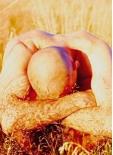A Midsummer Night's Dream - Open Air Theatre 2006
The Open Air Theatre in Regent's Park is certainly something special in the way of venues. Picnics on the lawn and some fine jazz in the bar combine to provoke a feeling of well-being and contentment even before one sets foot inside the theatre itself. Surrounded by huge mature trees, and accompanied by the fading chorus of our feathered friends, it's almost the perfect setting for 'A Midsummer Night's Dream', particularly since much of this play takes place in an enchanted wood.
Unfortunately, Kit Surrey's set reminds one more of an afternoon on a bowling green than an evening in a magical forest where scary fairies reign supreme, and where mortals are almost 'toys' in the hands of what one might more aptly describe as gods. Surrey has covered the entire acting area in a neatly manicured lawn of artificial grass, broken only by three 'humps' down which fairies and humans alike tumble or slide. After a while, the tumbling and sliding became repetitive, and one of the humps got its revenge when Dominic Marsh's Lysander pushed Sheridan Smith's Hermia over onto one of the smaller ones, and she fell back with a frightening thud that brought maternal gasps of concern from the audience. A case, perhaps of vengeance of the gods, or at least an actor who doesn't know his own strength!
Director Ian Talbot has revived his production of 'A Midsummer Night's Dream' from 2004 for this new season in the open air. Influenced by J M Barrie's Lost Boys in 'Peter Pan', it's a 'Dream' with 'bovver', because the fairies in Talbot's version all wear skinhead-like boots, sport bald heads and short-length trousers. But they never really managed to seem very scary, or scared for that matter, appearing rather dopey, if not demented, rather than threatening, or even mischievous. The head bovver boy, Oberon, the King of the Fairies, is not, however, a bovver dude at all. He turns out to be more akin to Christopher Lee's refined Dracula with hair swept back into a pony tail, pallid features and a floor-length coat - handy for sweeping the fallen leaves from the manicured lawn, I suppose.
The play focuses on three distinct groups: the bungling mechanicals who are rehearsing a dubious play about Thisbe and Pyramus; the fairies, who end up controlling the humans to one degree or another; and four lovers: Demetrius, Hermia, Helena and Lysander, who are finding it hard to get the guy/gal of their dreams. What's interesting about this play is to see how each group performs in comparison with the others. The mechanicals certainly have the best in humour, particularly Bottom, who's put under a spell by Puck and has his head turned into that of an ass. But in Talbot's production, it's the humans that come off best, giving spirited and energetic performances, peppered with some well-timed business, particularly where Lysander and Demetrius are both lying on the grass grovelling adoringly at Helena and synchronise their movements and speech.
John Hodgkinson has the height to wear the very large head of a very large ass, and he carries it off with some considerable humorous aplomb, utilising some realistic whinnying, though I thought his pawing of the ground was a little less believable - but I readily admit to a knowledge of our four-hoofed friends which would easily fit in a flea's satchel. Hodgkinson's fellow 'actors' also bring considerable humour to the 'play within a play', though I couldn't help feeling it was a little stretched. Still, it was an enjoyable, suitably bungling caper, that made a favourable impression on the responsive audience, though it never matched the highly original inventiveness which I saw in the RSC version in London earlier in the year, where Thisbe actually became grief-stricken and overwhelmed by the part. But Talbot and his team certainly notched up the laughs, and with some eerie lighting and sound effects, particularly as the natural light began to fade, there was a spark of magic, providing a glimmer of 'what might have been'.
Earlier in the week, I saw the opening of 'The Taming of the Shrew' at the same venue. On that occasion, Kit Surrey came up trumps with a magnificent reconstruction of an old Italian piazza which was charmingly realistic and incredibly impressive. However, the formality of his set for this production flouted Talbot's conception that Oberon and Titania's quarrel 'disrupts the elements', because there was no sense of disorder or chaos. Nor did it suit fairies dressed as 'bovver boys' who, in any case, didn't seem appropriate, principally because we have such an immutable notion of the questionable qualities and characteristics of 'skinheads'. Competent and humorous though it certainly is, what this production really needed was a lot less formality and a lot more magic in keeping with the idyllic suitability of this fine venue.
(Peter Brown)
Originally published on
